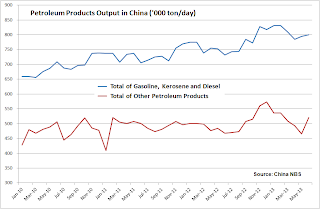Crude oil processing by Chinese refineries rose 10.8% on year to 39.60 million tonnes in June, while petroleum products inventories as of end-June increased 2.1% from a month ago to 29.75 million tonnes. The inventory level also rose from a year earlier for the first time since January.
Because credibility against Chinese
statistics is not enough and some official data like inventory figures are not
announced, it is difficult to grasp actual petroleum consumption in the
country.
The following chart shows the estimated combined
monthly consumption of gasoline, kerosene and diesel. The figures are
calculated by production data released by the National Bureau of Statistics
with customs data and estimated inventories based on Xinhua News data.
The three products are account for about
60% of total petroleum products output in China, according to the International
Energy Agency. Therefore, chart's proportion of crude oil processing and the
three products outputs seem to be roughly correct.
According to the chart, consumption of
combined products is in relatively steady upward tendency compared to
fluctuating crude oil processing.
Especially, gasoline output shows quite
stable increase in the monthly data released by statistics bureau as well. However,
growth of diesel production, that is the biggest among three products, is
slowing down since 2010.
On the other hand, monthly outputs of other
petroleum products that include naphtha or fuel oil etc. are almost capped at
around 500,000 tonnes per day since 2010, except for surprising surge during
October 2012 and February 2013. Except for gasoline, growth of industrial
petroleum products demand in China seems to be slowing apparently.
Recently, Chinese government has ordered to
domestic 19 industries to discard old inefficient excess production facilities
by the end of September this year.
Since many of these facilities already have
been idling due to the over capacity, the disposal of facilities is unlikely to
reduce fuel consumption significantly. But the policy proves the sluggish
growth of fuel demand over the past couple of years caused by large excess
production capacity in the Chinese industrial sector.



No comments:
Post a Comment